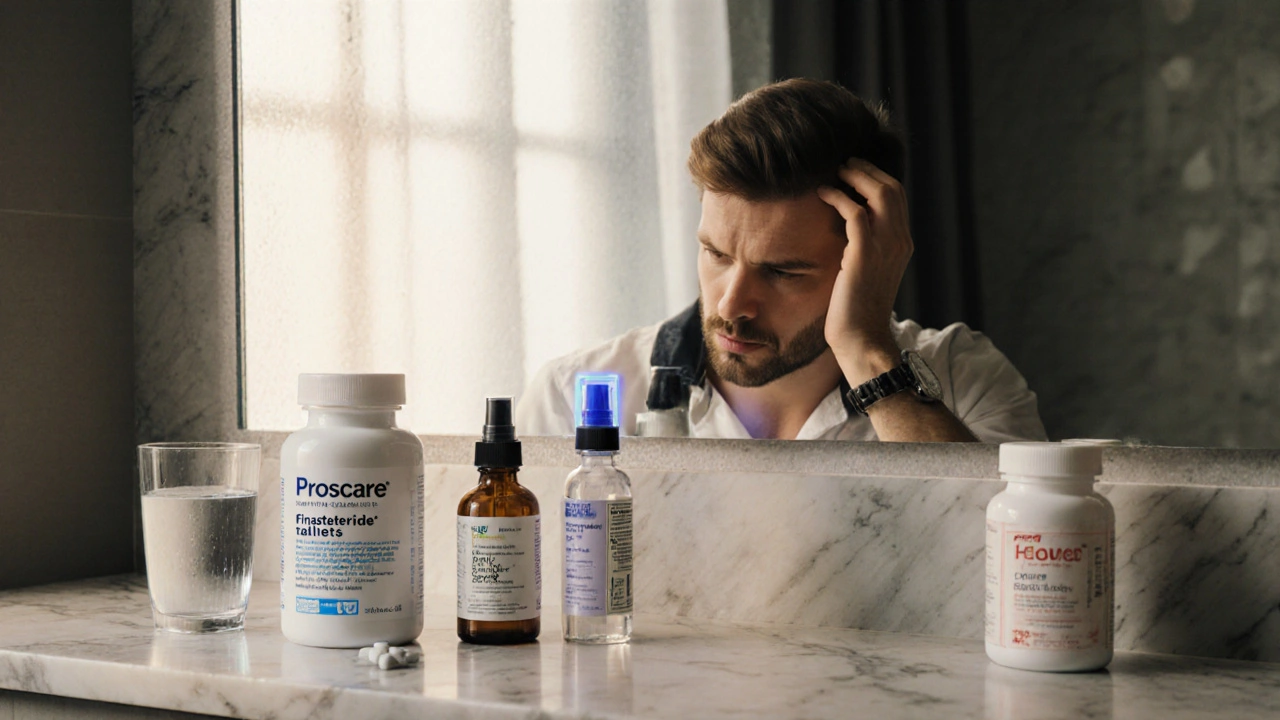Hair Loss Treatment Comparison Tool
Select Treatment Options to Compare
TL;DR
- Proscare is an oral finasteride 1mg tablet, proven to stop hair‑loss progression in about 85% of men.
- Minoxidil (topical) works by widening blood vessels; it's best for early‑stage thinning.
- Dutasteride is a stronger 5‑alpha‑reductase blocker but carries higher sexual‑side‑effect risk.
- Low‑level laser therapy (LLLT) is a non‑drug device that stimulates follicle metabolism.
- Platelet‑rich plasma (PRP) injections use your own growth factors to revitalize dormant follicles.
- Saw palmetto is a botanical supplement with modest evidence; it’s cheap but less reliable.
What Is Proscare (Finasteride)?
When it comes to treating male pattern baldness, Proscare is a brand of finasteride, an oral 5‑alpha‑reductase typeII inhibitor. Finasteride blocks the conversion of testosterone to dihydrotestosterone (DHT), the hormone that shrinks hair follicles on the crown and front of the scalp.
Key attributes:
- Typical dose: 1mg once daily.
- FDA‑approved for androgenetic alopecia in men.
- Clinical trials show ~48% of users experience measurable regrowth, while ~85% see a halt in further loss.
- Common side effects: decreased libido, erectile dysfunction, and rare mood changes.
Minoxidil - The Topical Workhorse
Minoxidil is a vasodilator originally developed for hypertension, later repurposed as a 2% or 5% topical solution for hair loss. It’s the only over‑the‑counter option that the FDA has cleared for both men and women.
Mechanism: Minoxidil opens potassium channels, increasing blood flow and delivering more oxygen and nutrients to hair follicles. The result is a longer anagen (growth) phase.
Pros: Easy to apply, minimal systemic exposure, works well in early‑stage thinning.
Cons: Requires twice‑daily application, can cause scalp irritation, and hair loss often resumes if you stop using it.
Dutasteride - The Stronger Oral Blocker
Dutasteride is a dual 5‑alpha‑reductase inhibitor (typeI+II) originally marketed for enlarged prostate. Because it suppresses DHT more completely than finasteride (about 90% vs 70%), many dermatologists use it off‑label for severe pattern baldness.
Typical dose: 0.5mg once daily.
Efficacy: Studies from 2023 show ~65% of men achieve visible regrowth, outperforming finasteride by roughly 10% points.
Side‑effect profile: Higher incidence of sexual dysfunction (up to 12%), occasional breast tenderness, and rare gynecomastia. Long‑term safety data are still accumulating.
Low‑Level Laser Therapy (LLLT) - Light‑Based Stimulation
Low‑level laser therapy (also called red‑light therapy) uses 630-680nm wavelengths to energize follicular cells. Handheld combs or head‑band devices deliver photons that boost ATP production in mitochondria.
Clinical evidence: A 2022 meta‑analysis of 19 randomized trials reported an average 19% increase in hair density after 24weeks of twice‑weekly treatment.
Advantages: Non‑invasive, no systemic side effects, can be used alongside medications.
Drawbacks: Requires consistent use, device cost ranges from $200 to $1,500, and results plateau after 6months for many users.

Platelet‑Rich Plasma (PRP) - Autologous Growth‑Factor Injections
Platelet‑rich plasma (PRP) therapy draws a small amount of the patient’s blood, centrifuges it to concentrate platelets, and injects the serum into the scalp. Platelets release PDGF, VEGF, and TGF‑β, which stimulate follicle stem cells.
Typical protocol: 3‑month series of monthly injections, followed by maintenance every 4-6months.
Outcomes: Real‑world data from 2024 suggest a median 30% increase in hair thickness after one year, especially when combined with finasteride.
Considerations: Procedure cost ($500-$2,000 per session), need for a qualified clinician, and variable response based on individual platelet quality.
Saw Palmetto - The Popular Plant Extract
Saw palmetto is a Serenoa repens berry extract marketed as a natural DHT blocker. It inhibits typeII 5‑alpha‑reductase in vitro, but its oral bioavailability is modest.
Typical dose: 320mg daily, taken in divided doses.
Evidence base: A 2021 double‑blind trial involving 100 men showed a 10% improvement in hair count versus placebo, far lower than finasteride’s 48%.
Pros & cons: Cheap, few side effects, but inconsistent efficacy; best used as an adjunct rather than a sole therapy.
Side‑by‑Side Comparison
| Attribute | Proscare (Finasteride) | Minoxidil | Dutasteride | LLLT | PRP | Saw Palmetto |
|---|---|---|---|---|---|---|
| Formulation | Oral tablet | Topical solution/foam | Oral capsule | Handheld/helmet device | Autologous injection | Oral supplement |
| Mechanism | 5‑α‑reductaseII inhibition (↓DHT) | Vasodilation → ↑ follicle blood flow | 5‑α‑reductaseI+II inhibition | Photobiomodulation → ↑ ATP | Growth‑factor release → stem‑cell activation | Weak 5‑α‑reductaseII inhibition |
| FDA Status | Approved for male pattern alopecia | Approved (2%/5%) | Off‑label (approved for BPH) | Medical‑device cleared | Not FDA‑approved for hair loss | Dietary supplement (no FDA claim) |
| Typical Dose | 1mg daily | 2% solution 1mL twice daily | 0.5mg daily | 10‑15min, 2‑3×/week | 3‑month induction, then q4‑6mo | 320mg daily |
| Avg. Regrowth (%) | ~48% | ~15‑25% | ~65% | ~19% | ~30% | ~10% |
| Common Side Effects | Sexual dysfunction, mood changes | Scalp irritation, itching | Higher sexual side‑effects, breast tenderness | Eye strain (rare), mild warmth | Injection pain, temporary swelling | GI upset (rare) |
| Annual Cost (US$) | ≈$120 | ≈$200‑$400 | ≈$300 | ≈$250‑$1,500 (device) | ≈$1,500‑$3,000 | ≈$30‑$60 |
How to Pick the Right Option for You
Deciding isn’t just about numbers; it’s about your lifestyle, budget, and tolerance for risk.
- First‑line, cost‑effective choice: Most dermatologists start with Proscare because the oral daily pill has strong evidence and a manageable side‑effect profile.
- If you can’t tolerate oral meds: Minoxidil or LLLT give you a drug‑free route, though you’ll need strict adherence.
- For aggressive loss or failed finasteride: Dutasteride may be worth a trial under physician supervision.
- When you want a procedural boost: PRP can amplify results when combined with any oral or topical agent.
- Budget‑tight, low‑risk supplement: Saw palmetto can be added, but don’t expect dramatic regrowth.
Always discuss with a healthcare professional before mixing therapies, especially if you’re on other medications or have a history of hormone‑sensitive conditions.
Potential Risks and How to Mitigate Them
Any hair‑loss treatment modifies hormone pathways or introduces foreign substances, so monitoring is key.
- Baseline labs: Before starting finasteride or dutasteride, get a PSA test and liver panel to rule out contraindications.
- Track side effects: Use a simple diary for sexual function, mood, and scalp reactions. If adverse events persist beyond 3 months, consider dose adjustment or switching.
- Drug interactions: Finasteride can amplify the effects of potent CYP3A4 inhibitors (e.g., ketoconazole). Alert your doctor.
- Procedure safety: For PRP, ensure the clinic follows sterile techniques and uses a certified centrifuge.
- Long‑term commitment: Hair regrowth typically plateaus; continued maintenance (monthly minoxidil, periodic PRP) may be needed to keep gains.
Bottom Line
There’s no one‑size‑fits‑all answer. Proscare remains the gold‑standard oral option for most men because of its solid evidence base and predictable dosing. However, alternatives like minoxidil, dutasteride, LLLT, PRP, and saw‑palmetto each fill a niche-whether you prefer a topical, a device, or a natural supplement. By weighing efficacy, side‑effect risk, convenience, and cost, you can craft a regimen that matches your personal goals.

Frequently Asked Questions
Can I use Proscare and minoxidil together?
Yes. Combining the oral DHT blocker with the topical vasodilator often yields better density than either alone, as they target different pathways. Just apply minoxidil to a dry scalp and take finasteride with food.
How long before I see results with Proscare?
Most men notice a slowdown in shedding within 8‑12 weeks. Visible regrowth typically appears after 4‑6 months of daily use.
Is dutasteride safe for long‑term use?
Clinical data up to 5years show it’s generally well‑tolerated, but sexual side effects are more common than with finasteride. Ongoing monitoring of hormone levels and PSA is recommended.
Do laser caps work for all hair types?
LLLT benefits are modest across ethnicities, but individuals with very coarse or tightly coiled hair may see slightly less penetration. Consistency over at least 6 months is essential.
What’s the biggest drawback of saw palmetto?
Its main issue is inconsistent potency-different supplement brands contain varying amounts of active fatty acids, leading to unpredictable results.





15 Comments
Melissa H.
Finasteride works, but make sure you check for side effects 🙃
Mary Magdalen
Let’s cut the crap – the U.S. market pushes Proscare like it’s the only savior while cheap alternatives get buried under bureaucratic nonsense. The data on finasteride is solid, but the hype machine ignores the real cost to men’s confidence when side effects hit. If you’re buying a $120 a year pill, ask why you’re not hearing about the cheaper herbal hacks that actually shave off a few bucks. This glorification reeks of corporate patriotism, not patient care. Wake up and look beyond the commercial veil.
harry wheeler
Finasteride reduces DHT yes it slows shedding and over months you’ll see regrowth it’s not instant but consistent use matters.
Pankaj Kumar
Look, if you’re worried about the sexual side‑effects, start low and monitor any changes. Pairing with a good scalp routine can buffer irritation. Many folks find that a steady 1 mg dose feels fine after the first few weeks. Keep an open dialogue with your dermatologist – they can adjust or suggest a break if needed. Remember, the benefits often outweigh the temporary discomfort.
sneha kapuri
Don’t be fooled by the glossy charts – finasteride’s DHT blockade can mess with your hormones for life. Some users report lingering libido loss even after quitting, and the mood swings are no joke. If you value mental stability, consider staying clear of that 5‑alpha‑reductase trap. Natural options, even if slower, keep your endocrine system intact.
Harshitha Uppada
i dunno why ppl spend so much on fancy laser caps when a simple comb does the job. the whole thing sounds like a scam to me lol. also the cost is insane for barely any change. just try a cheap minox the end.
Christian Freeman
The philosophical angle here is interesting: we treat our scalp like a battlefield, deploying chemicals to win a war we barely understand. It raises the question of whether we’re conquering hair loss or simply surrendering to societal pressure. Still, the practical side shows that finasteride remains a cornerstone, especially when combined thoughtfully with topical agents.
julie shayla
Oh sure, drop $300 on dutasteride and expect a miracle – because nothing says “smart choice” like emptying your wallet for a marginal gain. Meanwhile, a humble bottle of minoxidil sits on the shelf, doing its quiet job for a fraction of the price. If you love paying premium for hype, go ahead, but the results won’t magically outshine the data.
ADAMA ZAMPOU
May I inquire as to the long‑term implications of concomitant use of oral finasteride with low‑level laser therapy, particularly regarding cumulative DHT suppression and potential synergistic effects on follicular regeneration?
Liam McDonald
We understand that navigating treatment options can feel overwhelming and we appreciate your thorough research it is commendable to weigh efficacy cost and side effect profiles carefully we hope this discussion aids your decision making
Adam Khan
From a mechanistic perspective, finasteride functions as a selective 5‑α‑reductase type II inhibitor, effectuating a quantifiable decrement in dihydrotestosterone concentrations. However, the discourse surrounding its risk–benefit ratio often suffers from populist hyperbole, neglecting rigorous pharmacokinetic data. It is imperative to contextualize adverse event incidence within controlled trial parameters rather than anecdotal extrapolation.
Shawn Simms
While the efficacy percentages presented are derived from peer‑reviewed studies, it is essential to note that the sample sizes vary significantly across trials. Consequently, the confidence intervals for regrowth rates may overlap, suggesting that the apparent superiority of one agent over another may not be statistically robust.
Geneva Angeles
Choosing the right hair‑loss therapy can feel like navigating a labyrinth, but there’s a silver lining for anyone willing to explore the options.
First, recognize that Proscare (finasteride) offers a proven track record backed by decades of clinical evidence, making it a reliable anchor in your regimen.
Second, the convenience of a once‑daily oral pill cannot be overstated, especially for busy schedules where topical applications become a hassle.
Third, while side effects such as decreased libido may alarm some, studies show that the majority of men experience only mild, transient symptoms that often resolve with continued use or dosage adjustments.
Fourth, combining finasteride with minoxidil creates a synergistic effect, attacking hair loss from both hormonal and vascular angles, which many users report as a substantial boost in density.
Fifth, the cost of Proscare is relatively modest compared to high‑end laser devices or PRP sessions that can strain a budget without guaranteeing proportional results.
Sixth, for those skeptical of pharmaceuticals, low‑level laser therapy offers a drug‑free alternative, yet its efficacy hovers around the 19% mark-still respectable but generally lower than finasteride’s performance.
Seventh, PRP injections can be an excellent adjunct, delivering growth factors directly to the follicles, though the procedure’s expense and variability in outcomes warrant careful consideration.
Eighth, natural supplements like saw palmetto may provide a gentle DHT‑blocking effect, yet the evidence remains modest, making them better suited as supportive add‑ons rather than primary agents.
Ninth, dutasteride, with its broader inhibition of both type I and II 5‑α‑reductase, pushes efficacy up to roughly 65%, but its heightened side‑effect profile means it should be reserved for cases where finasteride falls short.
Tenth, personal tolerance plays a pivotal role-some men breeze through finasteride without a hitch, while others may need to pivot quickly to alternatives.
Eleventh, regular monitoring, including PSA checks and periodic hormone panels, empowers you to catch any unexpected changes early and adjust therapy accordingly.
Twelfth, community forums and support groups can provide real‑world insights that supplement clinical data, helping you set realistic expectations.
Thirteenth, patience is a virtue; hair regrowth typically becomes noticeable after four to six months, so steadfast adherence is crucial.
Fourteenth, never underestimate the psychological boost that comes from seeing even modest improvements-a confidence surge that can ripple into other life areas.
Fifteenth, in the grand scheme, the optimal strategy often blends a solid cornerstone like finasteride with complementary modalities tailored to your unique needs and budget.
Sixteenth, stay optimistic, stay informed, and remember that the journey to fuller hair is as much about mindset as it is about medication.
Scott Shubitz
The side‑effect saga of finasteride is often downplayed, yet the reality includes a spectrum of mood disturbances that can cripple daily life. Reports of anxiety, depression, and even cognitive fog have surfaced across forums, painting a darker picture than the glossy brochures suggest. When the market pushes a drug without transparent risk communication, it borders on negligence. Consumers deserve full disclosure, not a sanitized sales pitch. The drama isn’t just in the headlines; it’s lived by thousands who silently battle these unwanted symptoms. Ignoring them fuels a toxic cycle of shame and silence.
Soumen Bhowmic
I totally get the hesitation around jumping straight into finasteride, especially after hearing mixed stories online, so here’s a collaborative take: start with a low dose, track any changes in a simple spreadsheet, and pair it with a gentle scalp routine. If after three months you notice any adverse vibes, don’t panic-consult your doctor and discuss a possible switch to dutasteride or supplement it with minoxidil. This step‑by‑step approach keeps you in control and reduces the fear of unknown side effects. Plus, sharing your observations with a community can give you extra insights and moral support. Remember, it’s not a one‑size‑fits‑all scenario; it’s about tailoring the plan to your lifestyle and comfort level.